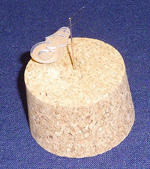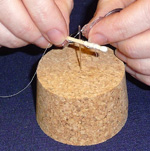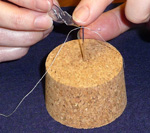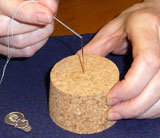Using a Wire Loop Needle Threader
Hints and organization tips for easier needle threading and sewing:
- Before starting any sewing project, organize your sewing materials on a tray with a raised edge or lip. You can cover the surface with a contrasting placement or use a flat, rubberized mat or jar opener that provides extra traction and stability for your needle threading materials.
- If you have low vision, make sure that the lighting in your sewing area provides sufficient illumination.
- When you purchase thread, ask the store clerk to release the thread end on each new spool.
- Use thread locks to keep the ends of threads from tangling. A thread lock is a small plastic disc that snaps into the hole on the end of a spool of thread and keeps the thread end securely in place. You can purchase thread locks at most sewing supply stores.
- Store your thread and matching bobbin in a small Ziploc bag or baby food jar with a label (large print or tactual) that identifies the color.
- Try using two pincushions: Use one on your wrist and place the other on your work surface or in your working area.
- Keep a refrigerator magnet nearby to help you locate dropped pins. You can also run it over the floor of your sewing area before you vacuum.
- A magnetic pincushion can make it easier to collect your pins and needles in one place and keep them accessible.
- And speaking of dropped pins, don’t sew barefoot or when wearing thin socks or slippers. Fallen pins can cause foot injuries, especially if you have diabetes and/or reduced sensation in your feet.
- You can also use pre-threaded needles. They are available in variety packs that contain either multiple thread colors or white and black thread only.
- Hint: Coat your thread with beeswax (available in most sewing and craft stores) to prevent it from breaking and splitting.
- Keep your scissors on a chain or a ribbon that you can place around your neck.
Threading Regular Eye Needles or Craft Needles
You can thread regular eye needles or craft needles by using a variety of commercially available devices and adaptations, including the Wire Loop Threader, the Hexe or Witch Threader, and the Infila Threader. You can find these needle threaders at most sewing supply stores or through specialty catalogs.
Use a Wire Loop Needle Threader:
 A wire loop needle threader is a small metal disk, or handle, attached to a thin wire loop that you push through the eye of the needle. This is how it works: (a) the thread is inserted through the wire loop, (b) the wire loop is pulled back out of the eye of the needle, and (c) the wire loop then pulls the thread through the eye of the needle.
A wire loop needle threader is a small metal disk, or handle, attached to a thin wire loop that you push through the eye of the needle. This is how it works: (a) the thread is inserted through the wire loop, (b) the wire loop is pulled back out of the eye of the needle, and (c) the wire loop then pulls the thread through the eye of the needle.
Some advantages of wire loop threaders:
- They are inexpensive and readily available.
- They can thread a wide assortment of hand and machine needle sizes.
Some disadvantages of wire loop threaders:
- They are not durable. You’ll have to replace your wire loop threader fairly regularly.
- They require good finger sensitivity and manual dexterity.
Before you begin:
- Assemble a wire loop threader, needle, thread, pincushion, a stabilizer for the needle (a cork or bar of soap), a straight pin or a match, scissors, and a tray to work on.
- Take a few moments to examine the wire loop with your fingers.
Here is a method for threading a needle with a wire loop threader:
- Stabilize the needle by placing the pointed/sharp end into a bar of soap or cork.

Place the sharp end of the needle in a bar of soap or cork.
- Grasp the top of the needle between your thumb and index finger and locate the “bulges” at the top of the needle. These bulges can help you locate the opening of the eye of the needle. (Note: If you’re right-handed, use your left hand to feel the bulges. If you’re left-handed, use your right hand for this step.)
- Locate the “bulges” at the top of the needle with your thumb and index finger.
- If you hold your thumb on one side of the bulge and your index finger on the other, the eye of the needle will be located between your fingers. This is where you will insert the wire loop.
- Keeping your fingers in place, use your other hand to grasp the wire loop by the metal disk (or handle) and insert/slide the wire loop into the spot between your thumb and index finger.

Insert/slide the wire loop into the spot between your thumb and index finger
- The wire loop will now be inserted into the eye of the needle.
- Remove your fingers and let go of the wire loop. It will remain in place and “hang” from the eye of the needle.

After letting go, the wire loop will “hang” from the eye of the needle.
- Locate the spool of thread and pull out approximately 18 inches. You can gauge 18 inches by measuring the distance from your fingertips to your elbow. (Note: Do not cut the thread at this point. Keep it connected to the spool since it is much easier to locate if it is still attached.)
- Wind the free end of the thread a few times around a straight pin or a match head.

- Pass the pin or match head through the wire loop until you have pulled through a few inches of thread.

- Unwind the thread from the pin or match head, ensuring that the wire loop is still inserted into the eye of the needle.

- Place the tip of your index finger lightly on top of the needle. Note: If you’re right-handed, use your left hand for this step. If you’re left-handed, use your right hand.

- Remove the wire loop from the eye of the needle by grasping the metal disk or handle and pulling it back out until the end of the thread is free from the wire loop. Keep pulling until the thread is completely free.

Pull the wire loop back out

Keep pulling

Keep pulling until the end of the thread is free from the wire loop …
- Your needle will now be threaded.

Your needle is now threaded.
- You can now cut the thread, severing it from the spool. Finish by making a knot of your choice.
By Maureen A. Duffy, M.S., CVRT